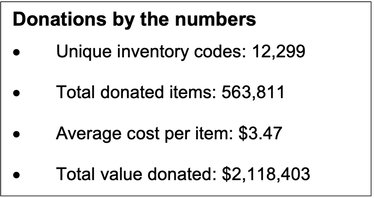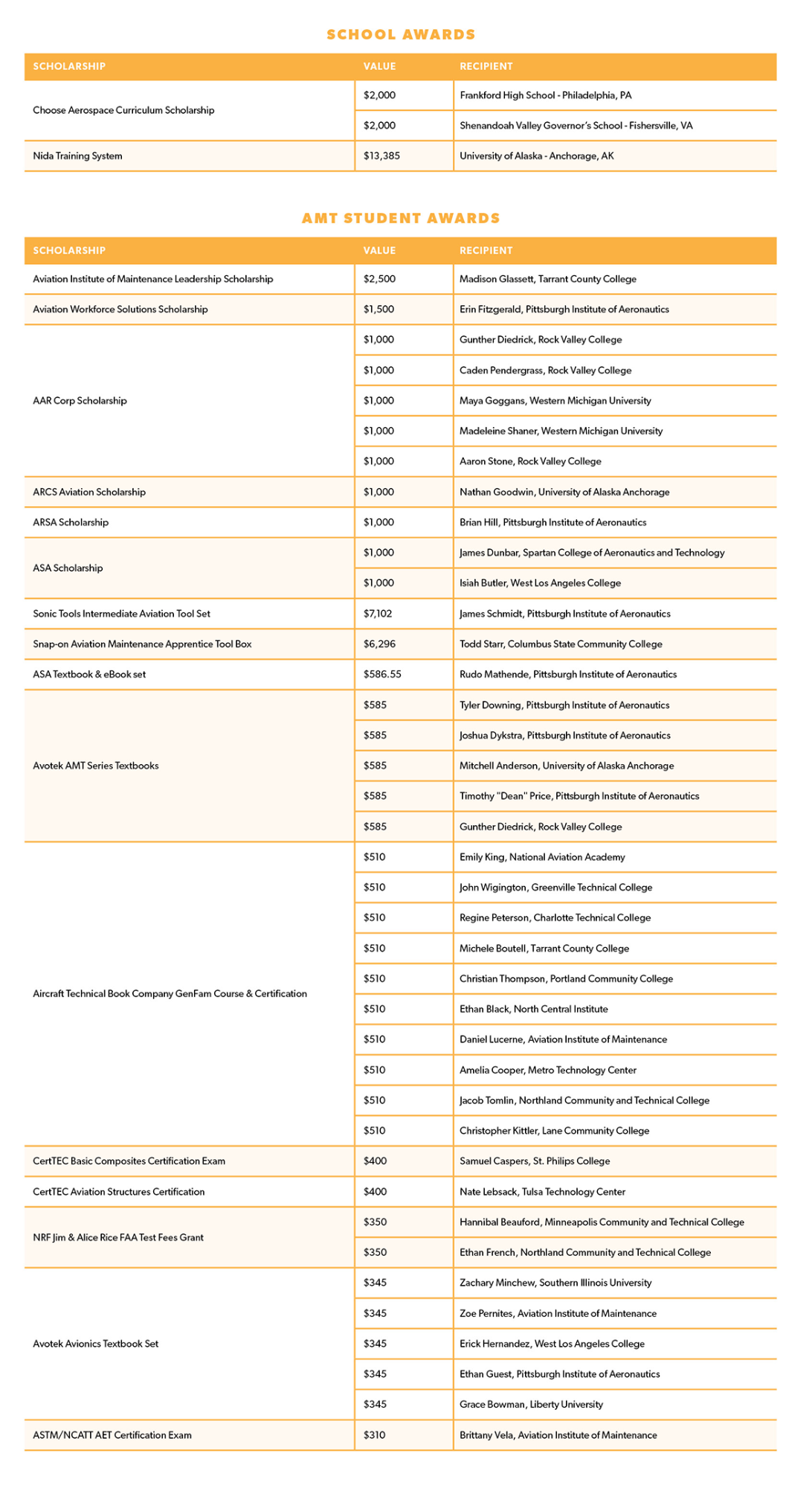0 Comments
Oklahoma CareerTech, a Choose Aerospace partner funding curriculum adoption across the state, recently announced that several Choose Aerospace program graduates from Putnam City High School are moving into the workforce. These graduates have been employed by local companies, JetSet, Aerovets Aviation, and AAR Corp, while some are also pursuing mechanic certification at the local A&P school, Metro Tech.
Putnam City High School also expanded its work-based learning program with AAR Corp as part of the company’s FAA workforce grant initiative. The MRO is providing ten Choose Aerospace students with internships this summer. Read more here. The Thrust Institute of Maintenance recently launched a podcast series where they deep dive into the world of aviation maintenance. On the most recent episode of the series, 'Nut's About Thrust', they sat down with Kelly Filgo, the Director of Operations for Choose Aerospace. Listen in to hear about the differences that Choose Aerospace is making for A&P students. Choose Aerospace is a non-profit organization that works to increase diversity and grow the pipeline of aviation maintenance workers. They do this by providing scholarships, training systems, textbooks, tools, and testing fee credits to educators and future aviators. FAA grant will help Choose Aerospace/Clemson University partnership reach more communities.
A program that provides high school students a pathway to an aviation maintenance career is expanding for the 2024-25 academic year thanks to a U.S. government grant that will provide financial aid and help grow the list of participating institutions. Choose Aerospace and the Clemson University Center for Workforce Development will use the $500,000 Federal Aviation Administration grant to expand their high school technical training program, with a focus on under-served communities. The grant will provide financial aid for up to 500 students around the country. Participating schools will be eligible to apply for the curriculum scholarship for up to 25 students. Schools are encouraged to apply for the funding, which will be provided on a first-come, first-served basis. The deadline to apply is August 1. For more information and to apply, visit https://www.chooseaerospace.org/curriculum.html. Centered around a curriculum developed by Clemson University, the Choose Aerospace technical training program provides high school students with initial training required to become an FAA certificated mechanic. The program is active in 31 schools across 15 states and has nearly 600 students. Enrollment is set to grow, with 14 schools seeking to add the program and 300 additional students planned for the coming academic year. "This grant will not only help grow the Choose Aerospace technical training program, but also will remove barriers to adoption so more institutions can join," said Choose Aerospace president and AAR Vice President Workforce Development Ryan Goertzen. "These career pathways are critical for the aviation industry, which faces a shortage of qualified mechanics. They also bolster career development programs, giving high school students an attractive pathway to high-paying jobs." The FAA grant expands funding available to Choose Aerospace participants. The organization also has an agreement with the Oklahoma Department of Career and Technology Education that covers training costs for up to 500 students in the state, where about half of the program's students are enrolled. Choose Aerospace also received subaward grant funds from the City of Rockford, Illinois, that covers tuition for students in that community, which is an emerging aviation maintenance center of excellence. The grants bolster support provided by other organizations, including many aviation companies that rely on a steady supply of qualified technicians. Choose Aerospace, a 501(c)(3) nonprofit organization, is proud to receive financial support from industry leaders such as AAR Corp. and the Aviation Institute of Maintenance. Such support is key to Choose Aerospace's goal of helping foster a diverse, well-qualified pool of aviation maintenance technicians. The organization's target is to develop a program that fully supports pathway progression for 10,000 enrolled students by 2027. About Choose Aerospace Choose Aerospace is a partnership of aerospace stakeholders including companies, associations, labor unions, and education institutions, united to help ensure the availability of a diverse, qualified technical workforce. A primary objective for Choose Aerospace is to make aerospace career and technical training a priority in secondary schools and to provide multiple career paths to success within the industry. For more information or to learn how you can support Choose Aerospace's mission, see www.chooseaerospace.org. Registration Open for Choose Aerospace Education Event: Teacher Training and INDUSTRY SHOWCASE4/24/2024 Registration is open for a comprehensive three-day event featuring Teacher Training and an Industry Showcase. Hosted by Tulsa Tech Riverside Campus in partnership with the Aviation Technician Education Council's (ATEC) Academy and Choose Aerospace, this event promises to equip educators with the tools and knowledge to deploy aviation maintenance curriculum in a high school setting.
Event Details: Dates: June 11-13, 2024 Location: Tulsa Tech Riverside Campus, 801 E 91st Street, Tulsa, OK 74132 Program Highlights:
Industry Showcase: Date: June 13, 2024 Time: 12:00-2:00 PM Venue: Tulsa Tech Riverside Campus About: Industry and A&P school representatives take advantage of the gathering and join educators from across the nation adopting the Choose Aerospace aviation maintenance curriculum for the upcoming academic year. Exhibitors will have tabletop space at the Industry Showcase, along with a directory listing attendees and programs incorporating the curriculum in the fall. Limited tabletop exhibit space and sponsorships are available. Reserve a table at https://www.chooseaerospace.org/exhibit.html Registration Information: Cost: Free for organizations approved for the Choose Aerospace Aviation Maintenance Curriculum. Don't miss this unparalleled opportunity to enhance your aerospace education program and connect with industry leaders. Register now to secure your spot! For more information and to register, visit https://www.chooseaerospace.org/teacher-training. Contact: Tarra Ruttman, Program Manager, [email protected], 888.262.2367 Choose Aerospace is proud to announce its slate of 2024 scholarship and award recipients. This year, a host of partner organizations sponsored over $55,000 worth of scholarships, textbooks, tool sets, training systems, and testing fee credits for educators and future aviators.
The entire slate of award winners are as follows:  AAR CORP., Choose Aerospace, and the Aviation Technician Education Council (ATEC) announce that their collaborative effort to donate surplus materials for educational purposes has reached a significant milestone, with over two million dollars’ worth of aviation inventory delivered to ATEC member schools in the first six months of the pilot program. “Since launching our EAGLE Career Pathway Program in 2018, AAR remains focused on finding meaningful ways to partner with AMT schools to help them grow to meet the employment needs of our industry," said AAR’s Senior Vice President of Repair & Engineering Tom Hoferer. “We remain steadfast in our commitment to support aviation maintenance education programs and their students, who may become future AAR employees.” Donated inventory includes items such as fasteners, fittings, hardware, sheet metal stock, electrical connectors, and wiring – all aimed at providing industry-specific items to directly benefit schools’ education programs. To ensure the donations are tailored to the specific needs of each school, the program allows institutions to select items from an inventory list on a first-come, first-served basis. ATEC member schools can access the donation request form and inventory list at https://www.atec-amt.org/parts-donation-request (ATEC member account required). Donations pass through Choose Aerospace, a 501(c)(3) non-profit, and are shipped directly to approved institutions. Schools are asked to cover shipping costs or arrange for pickup at one of AAR’s locations. The initiative is seen as a transformative venture by AAR’s Vice President of Workforce Development and Choose Aerospace’s President, Ryan Goertzen. "Finding a way to take aged inventory and repurpose these items for the education of future technicians is an initiative we’ve been working towards for a long time. AAR is proud to be one of the first to join this partnership, but we do not expect to be the last,” stated Goertzen. Companies interested in donating surplus material to educational institutions are encouraged to contact ATEC Operations Manager Tarra Ruttman at [email protected]. About AAR AAR is a global aerospace and defense aftermarket solutions company with operations in over 20 countries. Headquartered in the Chicago area, AAR supports commercial and government customers through four operating segments: Parts Supply, Repair & Engineering, Integrated Solutions, and Expeditionary Services. Additional information can be found at aarcorp.com. For more information on AAR’s EAGLE Career Pathway Program, visit https://www.aarcorp.com/en/careers/students/. About Choose Aerospace Choose Aerospace was formed by a partnership of aerospace stakeholders including companies, associations, labor unions, and education institutions, who joined to address the availability of a diverse, qualified technical workforce. A primary objective for Choose Aerospace is to make aerospace career and technical training a priority in secondary schools and to provide multiple career paths to success within the industry. For more information see www.chooseaerospace.org. About ATEC ATEC is a partnership of aviation maintenance training schools and employers. The council is dedicated to promoting and supporting technician education through its communications, advocacy programs, and networking events. To learn more, visit www.atec-amt.org.  Choose Aerospace is honored to welcome Kelly Filgo, a proven aviation education and training leader, as the organization's Director of Operations. Filgo, who brings more than two decades of relevant, firsthand experience to the newly created role, will focus on ensuring the smooth and efficient operation of Choose Aerospace’s educational programs. Among his primary responsibilities is overseeing the Choose Aerospace aviation maintenance curriculum, including updates and future expansions, and serving as the organization's primary liaison with schools that partner with Choose Aerospace. Filgo joins Choose Aerospace after more than a decade at Texas State Technical College, where he held a variety of roles, including department chair and statewide curriculum manager for their FAA Part 147 programs. A private pilot, certificated aircraft maintenance technician, and certificated drone pilot, Filgo has also served multiple terms on the Aviation Technical Education Council board of directors. In addition, he played a key role in developing the Choose Aerospace content that partners adopt as part of the organization's fundamental workforce pathway development efforts. "As Choose Aerospace pursues its goal to build and grow a diverse, sustainable aerospace workforce pipeline, the organization needs a strong, experienced, capable staff," said Executive Director Crystal Maguire. "Kelly brings a wealth of knowledge and relevant experience to support pre-certification pathways and high schools that adopt the Choose Aerospace curriculum. Filgo started his new role this month and is based in Waco, Texas. Choose Aerospace will provide nearly $60,000 worth of scholarships, textbooks, training systems, tools, and testing fee credits to educators and future aviators.
The non-profit organization is in its fifth award season. This year's donors include AAR Corp, Aeronautical Repair Station Association, Aviation Supplies & Academics (ASA), Aviation Workforce Solutions, Nida Corporation, AVOTEK, Aircraft Technical Book Company, CertTEC, Snap-on, Sonic Tools, Northrop Rice Foundation, and ARCS Aviation. Newcomer this year is the Aviation Institute of Maintenance with a $2,500 student award up for grabs. Choose Aerospace will provide high school award winners with free Choose Aerospace curriculum for up to ten students during the 23-24 academic year as well as complimentary ATEC membership. Eligible applicants must be planning to attend, enrolled at, or teach in an aviation technical program. Only ATEC members, their instructors and enrolled students are eligible to apply. The deadline to apply is February 15, 2024. If you or someone you know would like to serve on the review committee, please email [email protected]. JENKS, Oklahoma--Choose Aerospace and the Aircraft Owners and Pilots Association Foundation signed an agreement to establish a formal collaboration on their aviation education and workforce pipepline initiatives.
The parties will collaborate to “identify curriculum alignment, jointly promote each other’s educational materials, and pursue grant funding opportunities related to aviation,” according to the memorandum of understanding. The organizations hope that efforts to share ideas, best practices, and training resources will help both to meet the ongoing and increasing demand for pilots and mechanics. Key elements from the MOU, signed October 5, include review of curriculum benchmarks and competencies between the AOPA Foundation High School Aviation STEM Curriculum and the Choose Aerospace Aviation Maintenance Curriculum; cross-promotion of content and materials through websites, newsletters, social media, and joint presentations to schools/districts and industry events; and exploration of grant funding proposals related to K-12 aviation education. Recent data distributed by The Boeing Company forecasts the need for 690,000 technicians over the next 20 years—and this does not include business or general aviation demands. Domestic air travel has returned to pre-pandemic levels, and international travel is expected to return by 2024. Meanwhile, new sectors such as advanced air mobility are emerging and will demand a highly skilled workforce. The AOPA Foundation and Choose Aerospace play key roles in helping industry meet this this demand, workforce, providing education, training and employment pathways in the communities they serve. “This agreement allows the AOPA Foundation and Choose Aerospace to collaborate more closely,” said Glenn Ponas, AOPA Foundation director of high school outreach. “Together, we will be able to provide our respective curricula and resources to school districts and career technical centers and support them in creating pathways to careers as pilots, drone pilots, and aviation maintenance technicians.” The collaboration with the AOPA Foundation is the first of multiple efforts from Choose Aerospace to coordination and collaborate with partner aviation programs and resources. By working to reduce the duplication of efforts and provide educators with a comprehensive set of tools, Choose Aerospace will support wide-spread adoption of aviation programs that can meet both student needs and fill regional and aviation and aerospace workforce demands. “Aviation industry stakeholders recognize the need to invest resources and collaborate as part of developing a sustainable, diverse workforce,” said Ryan Goertzen, Vice President Workforce Development at AAR Corp and President of Choose Aerospace. “The Choose Aerospace-AOPA Foundation partnership will help both organizations maximize their already-productive efforts to feed aerospace’s workforce pipeline.” The partnership will be announced at the first AOPA Aviation and Aerospace Workforce Development Summit, which will be hosted at the Hyatt Regency Orlando International Airport on November 12. The AOPA You Can Fly High School Aviation STEM Symposium will follow the summit November 12 through 14. Both events are open to organizations that offer high school aviation curricula and resources. Register for the summit here. Register for the symposium here. ABOUT AOPA Since 1939, AOPA has protected the freedom to fly by creating an environment that gives people of all ages the opportunity to enjoy aviation and all it has to offer. AOPA is the world's largest community of pilots, aircraft owners and aviation enthusiasts, with representatives based in Frederick, Md., Washington, D.C., and seven regions across the United States. The association provides member services, including advocacy at the federal, state, and local levels, legal services, flight training and safety programs, and award-winning media. AOPA specializes in making aviation more accessible to everyone. To learn more, visit www.aopa.org. ABOUT CHOOSE AEROSPACE Choose Aerospace is a 501(c)(3) nonprofit partnership of aerospace stakeholders joined together to increase the availability of a diverse, qualified, technical workforce to support industry growth. A primary objective for Choose Aerospace is to make aerospace career and technical training a priority in secondary schools and to provide multiple career paths to success within the industry. Its aviation maintenance curriculum provides a resource for secondary and community-based programs to develop pathways to Federal Aviation Administration mechanic certification. For more information, visit chooseaerospace.org/curriculum. |
Archives
June 2024
Categories |
|
|
© 2024 Choose Aerospace, Inc.
501(c)(3) non-profit [email protected] • 888.262.2367 P.O. BOX 234 • JENKS, OK 74037 |





 RSS Feed
RSS Feed